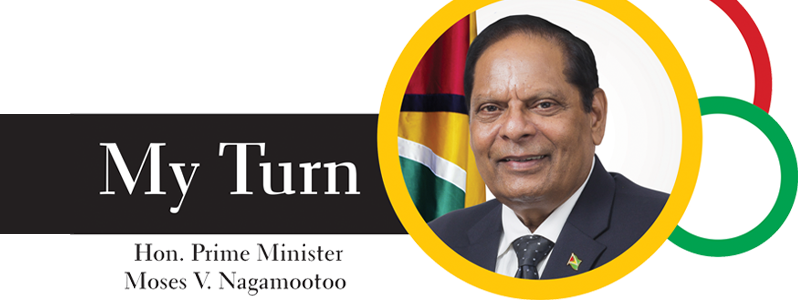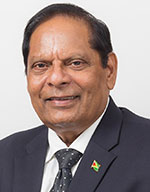AMERINDIAN Heritage Month will start on September 1, on the heels of the just-concluded National Toshaos Conference. This year’s celebrations will be held under the theme, “Guyana’s First Peoples: Sustaining a Rich Cultural Environment.”
The official launch on August 9 last coincided with International Day of the World’s Indigenous Peoples, and Guyana is proud to be associated with this worldwide tribute to our First Nations.
Last year, President David Granger gave a brilliant exposition on Heritage Month, which deserves repeating:
“Indigenous Heritage Month is a celebration of the breadth, depth and wealth of Guyana’s Indigenous cultures. It is a month to savour our diversity. It is a month to take concerted action to preserve, protect and promote the rich customs and traditions of the Indigenous peoples – the Akawaio, Arawak, Arecuna, Carib, Makushi, Patamona, Wai-Wai, Wapishana and Warrau.”
The President stated that Indigenous communities are the repositories of the cultural heritage of our first peoples; but this cultural heritage of our Indigenous communities “is under threat.”
He referred to the lowering over many years of education standards in hinterland communities; environmental degradation caused by mining and logging; inadequate infrastructure, vector-borne diseases and social problems such as alcoholism, abuse of girls and trafficking in persons. To these challenges we could add periodic flash floods and consequential destruction of roadways and bridges as we have seen in Regions Eight and Nine.
COORDINATED APPROACH
These issues require a coordinated approach for sustained resolution, which was why the President repeated his proposal that he had made last year for the establishment of a National Indigenous Peoples’ Authority (NIPA). This is intended to be an administrative agency with a national reach. It will help to implement policies made by the Ministry of Indigenous Peoples’ Affairs, decisions made by the National Toshaos Council and plans of the village councils.
At the National Toshaos Conference, Chairman Joel Fredericks repeated his commitment and those of his colleagues to work with the coalition Government to overcome the many challenges he had outlined. Some of these, he said, did not begin two years ago, but they would require continuing consultations, even though there could be issues on which they could not see eye-to-eye with Government.
I am heartened that our toshaos have opted for the positive approach, which was underlined by Vice-President Sydney Allicock. An acclaimed leader of our Indigenous peoples, he pleaded for all of our leaders to work towards the betterment of their communities. He reminded them that there is much over which our Indigenous peoples should be proud; there is much that is positive that should be celebrated.
POSITIVE PROJECTS
At the same event, Minister Valerie Garrido-Lowe highlighted some of the positive projects and programmes being rolled out by government in Indigenous communities. Among them are the Hinterland Employment and Youth Service (HEYS), the Community Development Project (CDP), Amerindian Land Titling (ALT) and the Jubilee Grant project. Some 2,000 young people have been enlisted in the HEYS programme and, this time around, they will get a bi-monthly stipend for actually attending classes where they will be taught relevant skills. Their education would result in their self-empowerment as they could get into their own businesses with start-up, seed capital from Government.
Efforts have been made to bridge the gap between the coast and the interior when our Government commissioned two outreach radio stations in Lethem and Mabaruma, as well as renovating Radio Paiwomak, to allow Indigenous and hinterland communities to access timely information, sports and entertainment. Very soon, new radio stations will be launched in other heavily populated Amerindian communities such as Mahdia, Bartica, Aishalton and Orealla. Next year, the sub-region, Moruca, is expected to be added to “Radio Land.” This is positive. This is huge!
NEW INNOVATIONS
Every year, these celebrations have seen new innovations by various indigenous communities, and new local products have been put on the market, some reaching the GuyExpo shelves. Years ago, reliance was on the traditional cassareep, cassava bread and farine, and tibisiri craft from places such as Kabakaburi.
Greater attention has since been paid to bottling, packaging and labelling, so that products from Indigenous producers appear attractive. Some time ago, I saw the Waini Secrets Crabwood Oil soaps, and the packaging was first-class. With help from the Institute of Applied Science and Technology (IAST), there appeared on the shelves refined organic skin cleansers which, I recall, were produced under the Rupununi essence brand.
Last year, the spotlight was on the Aranaputa peanut butter and this year, the lights will be on sun-dried tomatoes from Paramakatoi, which is finding a place on the menu of Guyana’s disciplined services and, hopefully, our hospitals.
NEW BOUNCE
Even the cultural shows by our Indigenous youths are taking on a new bounce, colour and variety. Participation in Carifesta and elsewhere on the world stage, helps not only to boost the proud image of our first peoples, but to also build their self-confidence in their ability to compete culturally.
I cannot end this piece without reference to our divisive politics, and caution our First Nations not to be side-tracked by vote-hunters who, unashamedly, would hand out tickets for cricket matches and invitations to lavish fetes, like the European conquerors did by doling out trinkets and mirrors.
They cannot allow themselves to fall prey to vicious propaganda, for instance, that the Coalition government will take away Amerindian lands; that the Coalition Government will amend the Amerindian Act! No proof has been given, yet these invented and speculative issues have been raised to create a dark cloud of fear and insecurity in hinterland communities.
PATRIOTIC SOLIDARITY
At a time when Guyana should be marshalling her rock-like, patriotic solidarity in the face the Venezuelan threat to our land and the security of our people, we cannot allow any side-shows and distractions.
This is a month when Guyana must with no equivocation acknowledge that our First Nations have been the best custodians of our land, our forests, our rivers, our savannahs, our fresh air. No one race or community owns it. No party should trade it. No claimants must conquer it. Our Guyana is indivisible, and we all belong to it.
I shared the immortal words of the celebrated American Chief Seattle, who was recorded as saying:
“And this we know: The earth does not belong to Man. Man belongs to the Earth…The air is precious; for all things share the same breath.” (Seattle Sunday Star on October 29, 1887).



.jpg)








